Winmate R19L300-SDA1 Manuel utilisateur
- Catégorie
- Téléviseurs
- Taper
- Manuel utilisateur
Ce manuel convient également à

Please read this instructions before operating the device and retain them for future reference.
SDI Display
10.1~32”
User Manual
Version 1.0
Document Part No.: 915211101040

2
10.1~32" SDI Display User Manual
Contents
Preface 3
About This User Manual ............................................................................................. 6
Chapter 1: Introduction 7
1.1 Overview .............................................................................................................. 8
1.2 Product Features .................................................................................................. 8
1.3 Package Contents ................................................................................................ 8
1.4 Product Overview ................................................................................................. 9
1.5 Interfaces ........................................................................................................... 10
1.6 OSD Control Panel ............................................................................................. 11
1.7 OSD Hot Keys .................................................................................................... 11
Chapter 2: Installation 12
2.1 Wiring Requirements .......................................................................................... 13
2.2 Cable Mounting Considerations ......................................................................... 13
2.3 Connecting Power .............................................................................................. 13
2.4 Mounting Guide .................................................................................................. 14
2.5 Connecting Peripherals ...................................................................................... 15
2.5.1 VGA Connector ........................................................................................ 15
2.5.2 HDMI Connector ....................................................................................... 15
2.5.3 3G-SDI Output Connector ........................................................................ 16
2.5.4 3G-SDI Input Connector ........................................................................... 16
2.5.5 CVBS Connector ...................................................................................... 16
2.5.6 Power Input Connector ............................................................................. 16
3.1 Turning on the System ....................................................................................... 17
Chapter 3: Operating the Device 18
3.2 OSD Menu Navigation ........................................................................................ 19
3.3 Troubleshooting Guide ....................................................................................... 21
Appendix 22
Appendix A: Frequency Table .................................................................................. 23

3
Preface
Preface
Copyright Notice
No part of this document may be reproduced, copied, translated, or transmitted in any form or
by any means, electronic or mechanical, for any purpose, without the prior written permission
of the original manufacturer.
Trademark Acknowledgement
Brand and product names are trademarks or registered trademarks of their respective owners.
Disclaimer
We reserve the right to make changes, without notice, to any product, including circuits and/or
software described or contained in this manual in order to improve design and/or performance.
We assume no responsibility or liability for the use of the described product(s) conveys no
license or title under any patent, copyright, or masks work rights to these products, and make
no representations or warranties that these products are free from patent, copyright, or mask
work right infringement, unless otherwise specified. Applications that are described in this
manual are for illustration purposes only. We make no representation or guarantee that such
application will be suitable for the specified use without further testing or modification.
Warranty
Our warranty guarantees that each of its products will be free from material and workmanship
defects for a period of one year from the invoice date. If the customer discovers a defect, we
will, at his/her option, repair or replace the defective product at no charge to the customer,
provide it is returned during the warranty period of one year, with transportation charges
prepaid. The returned product must be properly packaged in its original packaging to obtain
warranty service. If the serial number and the product shipping data differ by over 30 days, the
in-warranty service will be made according to the shipping date. In the serial numbers the third
and fourth two digits give the year of manufacture, and the fifth digit means the month (e. g.,
with A for October, B for November and C for December).
For example, the serial number 1W16Axxxxxxxx means October of year 2016.
Customer Service
We provide a service guide for any problem by the following steps: First, visit the website of
our distributor to find the update information about the product. Second, contact with your
distributor, sales representative, or our customer service center for technical support if you
need additional assistance.
You may need the following information ready before you call:
Product serial number
Software (OS, version, application software, etc.)
Description of complete problem
The exact wording of any error messages
In addition, free technical support is available from our engineers every business day. We are
always ready to give advice on application requirements or specific information on the
installation and operation of any of our products.

4
10.1~32" SDI Display User Manual
Naming Rule
R10LXXX-SDXX
Item
Description
R
Panel Type
10
Panel Size
LXXX
Product Size
SD
Mechanical Type (SDI)
XX
Panel Model
Advisory Conventions
Four types of advisories are used throughout the user manual to provide helpful information or to
alert you to the potential for hardware damage or personal injury. These are Notes, Important,
Cautions, and Warnings. The following is an example of each type of advisory.
Note:
A note is used to emphasize helpful information
Important:
An important note indicates information that is important for you to know.
Caution/ Attention
A Caution alert indicates potential damage to hardware and explains how
to avoid the potential problem.
Unealerted’ attention indique un dommage possible à l’équipement et
explique comment éviter le problem potentiel.
Warning!/ Avertissement!
An Electrical Shock Warning indicates the potential harm from electrical
hazards and how to avoid the potential problem.
Un Avertissement de Choc Électriqueindique le potentiel de chocssur des
emplacements électriques et comment éviterces problèmes.
Alternating Current / Mise à la Terre The Protective Conductor
Terminal (Earth Ground) symbol indicates the potential risk of serious
electrical shock due to improper grounding.
Le symbole de Miseà Terre indique le risqué potential de choc électrique
grave à la terre incorrecte.

5
Preface
Safety Information
Warning!/ Avertissement!
Always completely disconnect the power cord from your chassis
whenever you work with the hardware. Do not make connections while
the power is on. Sensitive electronic components can be damaged by
sudden power surges. Only experienced electronics personnel should
open the PC chassis.
Toujours débrancher le cordon d’alimentation du chassis lorsque vous
travaillez sur celui-ci. Ne pas brancher de connections lorsque
l’alimentation est présente. Des composantes électroniques sensibles
peuvent être endommagées par des sauts d’alimentation. Seulement du
personnel expérimenté devrait ouvrir ces chassis.
Caution/ Attention
Always ground yourself to remove any static charge before touching the
CPU card. Modern electronic devices are very sensitive to static electric
charges. As a safety precaution, use a grounding wrist strap at all times.
Place all electronic components in a static-dissipative surface or static-
shielded bag when they are not in the chassis.
Toujours verifier votre mise à la terre afin d’éliminer toute charge statique
avant de toucher la carte CPU. Les équipements électroniques moderns
sont très sensibles aux décharges d’électricité statique. Toujours utiliser
un bracelet de mise à la terre comme précaution. Placer toutes les
composantes électroniques sur une surface conçue pour dissiper les
charge, ou dans un sac anti-statique lorsqu’elles ne sont pas dans le
chassis.
Safety Precautions
For your safety carefully read all the safety instructions before using the device. Keep
this user manual for future reference.
Always disconnect this equipment from any AC outlet before cleaning. Do not use
liquid or spray detergents for cleaning. Use a damp cloth.
For pluggable equipment, the power outlet must be installed near the equipment
and must be easily accessible.
Keep this equipment away from humidity.
Put this equipment on a reliable surface during installation. Dropping it or letting it
fall could cause damage.
The openings on the enclosure are for air convection and to protect the equipment
from overheating.
Before connecting the equipment to the power outlet make sure the voltage of the
power source is correct.
Position the power cord so that people cannot step on it. Do not place anything over
the power cord.
If the equipment is not used for a long time, disconnect it from the power source to
avoid damage by transient over-voltage.
Never pour any liquid into an opening. This could cause fire or electrical shock.
Never open the equipment. For safety reasons, only qualified service personnel
should open the equipment.
All cautions and warnings on the equipment should be noted.

6
10.1~32" SDI Display User Manual
Caution/ Attention
Always ground yourself to remove any static charge before touching the
board. Modern electronic devices are very sensitive to static electric
charges. As a safety precaution, use a grounding wrist strap at all times.
Place all electronic components in a static-dissipative surface or static-
shielded bag when they are not in the chassis.
Caution/ Attention
Do not cover the openings!
About This User Manual
This User Manual provides information about using the Winmate® SDI Display. The
documentation set provides information for specific user needs, and includes:
SDI Display User Manual – contains detailed description on how to use the display, its
components and features.
Note:
Some pictures in this guide are samples and can differ from actual product.
Document Revision History
Version
Date
Note
1.0
25-Jan-2019
New document release.

7
Chapter 1: Introduction
Chapter 1: Introduction
This chapter gives you product overview, describes features and
hardware specification. You will find all accessories that come
with the display device in the packing list. Mechanical dimensions
and drawings included in this chapter.

8
10.1~32" SDI Display User Manual
1.1 Overview
Congratulations on purchasing Winmate® SDI Display. When you need high quality SDI
monitoring, Winmate monitors are the perfect solution! Long distance up to 100 meters
transmission with no data compression with 3G SDI input and output.
1.2 Product Features
Winmate® SDI Display features:
10.1~-32” TFT LCD
1x HDMI, 1x VGA, 2 x CVBS (BNC)
1 x 3G-SDI in, 1 x 3G-SDI out (loop out)
Chassis housing
Sleek and flush mounts
Suitable for industrial applications
1.3 Package Contents
Carefully remove the box and unpack your display. Please check if all the items listed below are
inside your package. If any of these items are missing or damaged contact us immediately.
Standard factory shipment list:
Display
User Manual
(Hardcopy)
Black screw
bolts**
110~240V AC
Power Adapter
Varies by product
Part No. 915211101040
Varies by product
Varies by product
Power Cord
VGA Cable
HDMI Cable
SDI Cable
Varies by country
Part No. 9441151150P4
Part No. 94E0190190P3
Part No. 9470020020K1
CVBS cable
Part No. 947018102000
**Notice: Screw bolts provided by Winmate only to be used to screw the display onto a console
from the rear side. If you prefer your own bolts, please make sure to use M4 and 30mm in length.

9
Chapter 1: Introduction
1.4 Product Overview
This section describes physical appearance of the SDI Display.
Note:
Notice that standard input terminals include VGA and HDMI. Your device may be
equipped with DVI, S-Video or Composite input terminals based on your order.
Notice that input and output connectors vary by product size and specifications. The picture above
shows only a prototype model for information purposes only.
Mechanical dimensions and appearance
Notice that input and output connectors vary by product size and specifications. The picture above
shows only a prototype model for information purposes only.
Item
Description
❶
Connectors – Display input and output connects. The choice varies by order
specifications.
❷
OSD Control Panel – On-screen display control panel consists of physical buttons
and LED indicators.
❸
VESA – VESA pattern for wall, desk mounting.
❹
Speaker – Audio output. Optional feature.

10
10.1~32" SDI Display User Manual
Refer to the table below for a unit dimensions.
Panel Size
Model Name
Dimensions
(W x H x D, mm)
VESA
(W x H), mm
10.1”
W10L100-SDH2
263.6 x 172.3 x 38.5
75 x 75
15”
R15L100-SDA3
350.2 x 274.2 x 38.5
100 x 100
19”
R19L300-SDA1
438.7 x 363.5 x 38.9
100 x 100
21.5”
W22L100-SDA3
518.1 x 314 x 38.5
100 x 100
32”
W32L100-SDA3
775.6 x 475.6 x 55
200 x 200
1.5 Interfaces
Display input and output connectors are located on the bottom side.
Item
Description
Power Jack – Connects computer to source of power.
USB for Touch - Connects USB for touch capabilities.
VGA (RGB) –Transmits video from a PC to a monitor.
Example: A notebook PC to a monitor.
HDMI 1.3 – Transmits and protects copyrighted digital video and audio.
Example: An HD tuner to an HD ready TV.
3G-SDI output - Transmits 3G SDI analog signals from display.
3G-SDI input - Transmits 3G SDI analog signals to display.
CVBS - Transmits CVBS analog signals to display.

11
Chapter 1: Introduction
1.6 OSD Control Panel
OSD control panel varies by product specifications. Physical buttons and LED indicators are
located on the OSD control panel the rear side of the display.
Control Buttons
Function
POWER - Initiates power-up sequence from low power mode or enters low
power mode from normal operation.
UP- Selects the previous item in the Menu.
DOWN- Selects the next item in the Menu.
MENU/ ENTER
i. When OSD is disabled, it displays the OSD Main Menu.
ii. When OSD is enabled, it confirms a selection.
LEFT - Moves left in the menu or bar.
RIGHT - Moves right in the menu or bar.
EXIT - i. When OSD is enabled, it returns to the previous menu level or closes
the OSD.
AUTO - Perform Auto Adjustment.
1.7 OSD Hot Keys
Function
Hot Key
Main source
Press “ ” to select the main source.
Volume
Press “ ” to the volume bar, and press “ ” “ ” to adjust
the volume.
Auto adjustment
Press “AUTO” to perform auto adjustment.

12
10.1~32" SDI Display User Manual
Chapter 2: Installation
This chapter provides hardware installation instructions and
mounting guide for all available mounting options. Pay attention
to cautions and warning to avoid any damages

13
Chapter 2: Installation
2.1 Wiring Requirements
The following common safety precautions should be observed before installing any electronic
device:
Strive to use separate, non-intersecting paths to route power and networking wires. If power
wiring and device wiring paths must cross make sure the wires are perpendicular at the
intersection point.
Keep the wires separated according to interface. The rule of thumb is that wiring that shares
similar electrical characteristics may be bundled together.
Do not bundle input wiring with output wiring. Keep them separate.
When necessary, it is strongly advised that you label wiring to all devices in the system.
Caution
Do not run signal or communication wiring and power wiring in the same conduit. To avoid
interference, wires with different signal characteristics (i.e., different interfaces) should be
routed separately.
Be sure to disconnect the power cord before installing and/or wiring your device.
Verify the maximum possible current for each wire gauge, especially for the power cords.
Observe all electrical codes dictating the maximum current allowable for each wire gauge.
If the current goes above the maximum ratings, the wiring could overheat, causing serious
damage to your equipment.
Be careful when handling the unit. When the unit is plugged in, the internal components generate
a lot of heat which may leave the outer casing too hot to touch.
2.2 Cable Mounting Considerations
For a nice look and safe installation, make sure cables are neatly hidden behind the device.
Caution/ Attention
Observe all local installation requirements for connection cable type and
protection level.
Suivre tous les règlements locaux d’installations, de câblage et niveaux de
protection.
Caution/ Attention
Turn off the device and disconnect other peripherals before installation.
Éteindre l’appareil et débrancher tous les périphériques avant l’installation.
2.3 Connecting Power
This section provides information on how to use connectors on the Chassis Display. Be cautious
while working with these modules. Please carefully read the content of this chapter in order to
avoid any damages.

14
10.1~32" SDI Display User Manual
Installation instruction:
1. Connect the AC cord to the AC IN terminal on the AC adaptor.
2. Connect the DC OUT terminal of the AC adaptor to the DC IN terminal on the monitor.
3. Align the notch on the cord connector with the guiding groove and plug it in.
4. Connect the AC cord plug to the power outlet.
2.4 Mounting Guide
The SDI Display can be applied for several different installation methods, including chassis
mounting, VESA mounting. Refer to sub-sections below for more details.
Caution/ Attention
Follow mounting instructions and use recommended mounting hardware to avoid
the risk of injury.
Suivez les instructions de montage et d'utilisation recommandé le matériel de
montage pour éviter le risque de blessure.
VESA Mount
SDI Display comes with VESA Mount holes for mounting.
Installation Instruction:
1. Screw VESA bracket to the fixture (ex. swing arm) with four VESA screws.
2. Place the device on VESA bracket.
Notice that VESA stand and mounting kit are not provided by Winmate.

15
Chapter 2: Installation
2.5 Connecting Peripherals
The panel control port is designed for monitors that work with a variety of compatible video
sources. Due to the possible deviations between these signal sources, you may have to make
adjustments to the monitor settings from the OSD menu when switching between these sources.
Note:
Notice that standard input terminals include VGA and HDMI. Your device
may be equipped with DVI-D, S-Video or Composite input terminals based
on your order.
2.5.1 VGA Connector
Chassis Display uses standard 15pin D-sub connector. Plug 15-pin VGA signal cable to the VGA
connector in the rear of motherboard, and plug the other end to the monitor. Secure cable
connectors with hexagonal copper pillars M3x4mm.
Pin assignment and signal names of VGA connector
2.5.2 HDMI Connector
Plug HDMI signal cable to the HDMI connector on the rear side of PC system, and plug the other
end to the monitor.
Pin assignment and signal names of HDMI connector
Pin №
Signal Name
Pin №
Signal
Name
1
RED
2
GREEN
3
BLUE
4
NC
5
GND
6
AGND
7
AGND
8
AGND
9
VGA_5V
10
GND
11
NC
12
DDCSDA
13
H Sync
14
V Sync
15
DDCSCL
Pin №
Signal Name
Pin №
Signal Name
1
HDMI_RX2+
2
GND
3
HDMI_RX2-
4
HDMI_RX1+
5
GND
6
HDMI_RX1-
7
HDMI_RX0+
8
GND
9
HDMI_RX0-
10
HDMI_RXC+
11
GND
12
HDMI_RXC-
13
HDMI_CON_CEC
14
NC
15
HDMI_CON_SCL
16
HDMI_CON_SDA
17
GND
18
+5V_HDMI
19
HDMI_CON_HP

16
10.1~32" SDI Display User Manual
2.5.3 3G-SDI Output Connector
Pin assignment and signal names of 3G-SDI output connector
2.5.4 3G-SDI Input Connector
Pin assignment and signal names of 3G-SDI input connector
2.5.5 CVBS Connector
Pin assignment and signal names of CVBS connector
Composite Video Signal
2.5.6 Power Input Connector
Pin assignment and signal names of power jack connector
Pin №
Signal Name
1
SDI_OUTPUT
2
GND
Pin №
Signal Name
1
SDI_INPUT
2
GND
Pin №
Signal Name
1
+12V DC
2
GND
3
Case GND

17
Chapter 2: Installation
3.1 Turning on the System
To turn on the system:
1. Connect the power adapter cable to the DC IN of the display.
2. Connect the power cord to the power adapter.
3. Connect the power cord to a power outlet.
4. Press the power button located on the OSD control panel on the rear to turn on the system.

18
10.1~32" SDI Display User Manual
Chapter 3: Operating the Device
In this chapter you will find instructions on how to operate the
display.

19
Chapter 3: Operating the Device
3.2 OSD Menu Navigation
OSD Icon
Sub-menu
Settings
Note
DISPLAY
BRIGHTNESS
slider bar
Default 50
Use to adjust the screen’s brightness. Range 0 to 100
CONTRAST
slider bar
Default 50
Use to adjust the screen’s contrast. Range 0 to 100
SHARPNESS
slider bar
Default 50
Use to adjust the screen’s sharpness. Range 0 to 100
ADC BRIGHTNESS
slider bar
Default 50
Use to adjust the screen’s ADC brightness. Range 0 to 100
HUE
slider bar
Default 50 CVBS Only
Use to adjust the screen’s HUE. Range 0 to 100
SATURATION
slider bar
Default 50 CVBS Only
Use to adjust the screen’s Saturation. Range 0 to 100
COLOR TEMPERATURE
User/ 6500/ 9300
User
Adjusts the color temperature of the entire screen
COLOR CONTROL
R slider bar
G slider bar
B slider bar
Default 50
Use to adjust the screen’s R,G,B color. Range 0 to 100
GAMMA
NATIVE/ 1.8/ 2.2
NATIVE
Select a display gamma value for best picture quality.
ADJUST
AUTO SETUP (VGA only)
Press ENTER
Default OFF
Automatically adjusts screen size, H position, V position, Clock, Clock Phase
AUTO ADJUSTMENT (VGA
only
ON/ OFF
Default OFF
H Position, V Position and Clock Phase are adjusted automatically upon power on.
H POSITION (VGA)
Slider bar
N/A
Controls the horizontal position of the image within the Display area of the LCD. Range
0 to 100
V POSITION (VGA)
Slider bar
N/A
Controls the vertical position of the image within the Display area of the LCD. Range 0
to 100
CLOCK (VGA)
Slider bar
N/A
Adjust the width of the image. Range 0 to 100
PHASE (VGA)
Slider bar
N/A
Adjusts the visual “noise” on the image. Range 0 to 63
WHITE BALANCE (VGA)
Press ENTER
Perform the white balance
SCALING
(VGA, HDMI, CVBS, SDI)
ASPECT
OFF
Default CUSTOM
Adjust the image scaling setting
AUDIO
VOLUME
slider bar
Default 10
Adjust the volume. Range 0 to 31
Turn the mute ON / OFF
PIP
PIP SOURCE
VGA/ HDMI
CVBS1/ CBVS2/ SDI
N/A
Select the PIP source from the input signal
PIP Mode
OFF/ PIP/ POP
SIDE BY SIDE ASPECT
SIDE BY SIDE FULL
Default OFF
Select the PIP Mode of display
PIP SIZE
SMALL
MIDDLE
LARGE
Default SMALL
Configure the PIP display size.
PIP POSITION
H POSITION slider bar
V POSITION slider bar
Default 100
Controls the horizontal / vertical position of the PIP image Range 0 to 100

20
10.1~32" SDI Display User Manual
OSD Icon
Sub-menu
Settings
Note
OSD
OSD TURN OFF
slider bar
Default 10
Turns off the OSD after a period of inactivity. The preset choices are 0-60 seconds.
OSD POSITION
H POSITION slider bar
V POSITION slider bar
Default 50
Determines the location where the OSD appears on the screen. Range 0 to 100
MONITOR INFORMATION
N/A
Show BIOS version & resolution info.
OSD TRANSPARENCY
OFF
TYPE1
TYPE2
Default OFF
Select the transparency level of OSD
ADVANCED
INPUT DETECT
NONE
AUTO DETECT
Default mode
Configure the input detect function yes or not
CHANNEL SELECT
VGA
HDMI
CVBS1
CBVS2
SDI
Switch the setting of signal input
SCAN MODE
OVER SCAN
UNDER SCAN
Default OVER SCAN
Select the Scan mode
BRIGHTNESS MIN
slider bar
Default 10
Setting the Minimum of the brightness. Range 0 to 10
FACTORY RESET
YES / NO
Default No
Resets OSD options back to factory settings
La page est en cours de chargement...
La page est en cours de chargement...
La page est en cours de chargement...
La page est en cours de chargement...
-
 1
1
-
 2
2
-
 3
3
-
 4
4
-
 5
5
-
 6
6
-
 7
7
-
 8
8
-
 9
9
-
 10
10
-
 11
11
-
 12
12
-
 13
13
-
 14
14
-
 15
15
-
 16
16
-
 17
17
-
 18
18
-
 19
19
-
 20
20
-
 21
21
-
 22
22
-
 23
23
-
 24
24
Winmate R19L300-SDA1 Manuel utilisateur
- Catégorie
- Téléviseurs
- Taper
- Manuel utilisateur
- Ce manuel convient également à
dans d''autres langues
- English: Winmate R19L300-SDA1 User manual
Documents connexes
-
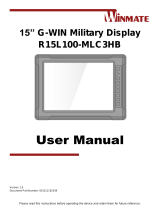 Winmate R15L100-MLC3HB Manuel utilisateur
Winmate R15L100-MLC3HB Manuel utilisateur
-
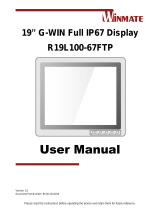 Winmate R19L100-67FTP Manuel utilisateur
Winmate R19L100-67FTP Manuel utilisateur
-
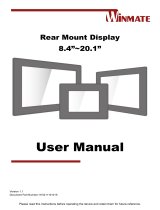 Winmate 19L RM Series Manuel utilisateur
Winmate 19L RM Series Manuel utilisateur
-
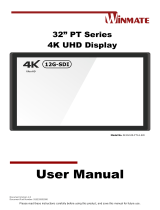 Winmate 32” PT Series Manuel utilisateur
Winmate 32” PT Series Manuel utilisateur
-
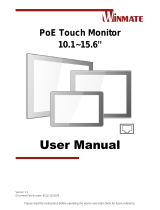 Winmate W10L100-PCH2-PoE Manuel utilisateur
Winmate W10L100-PCH2-PoE Manuel utilisateur
-
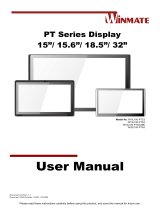 Winmate W15L100-PTA3 Manuel utilisateur
Winmate W15L100-PTA3 Manuel utilisateur
-
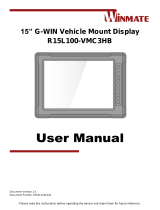 Winmate R15L100-VMC3HB Manuel utilisateur
Winmate R15L100-VMC3HB Manuel utilisateur
-
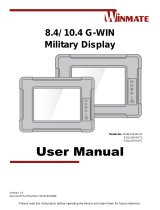 Winmate R10L100-MLP1 Manuel utilisateur
Winmate R10L100-MLP1 Manuel utilisateur































